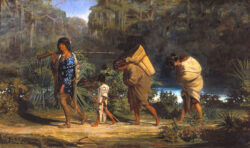Alfred L. Boisseau
Alfred Boisseau lived and painted in New Orleans from 1845 to 1849 and was one of the earliest known artists to open a studio in the city.

Courtesy of New Orleans Museum of Art
Louisiana Indians Walking Along Bayou. Boisseau, Alfred L. (artist)
Trained in France, Alfred L. Boisseau painted in New Orleans for only two years, between 1845 and 1846. Yet he made a lasting mark on the painting of Louisiana, completing some of the earliest genre and landscape paintings in the city. In a market dominated by portraits, Boisseau laid a foundation for appreciation of the Louisiana landscape. Other early Louisiana artists such as Jacques Amans, Adolph Rinck, and Franz Joseph Fleischbein advertised their skill at view painting during the 1830s and 1840s. But this historical record suggests a dim market for landscapes in Louisiana, at least until the Civil War, when John Antrobus and Richard Clague (and his students) struck a chord with patrons with naturalistic, Barbizon-inspired landscapes.
Boisseau was born in Paris on January 23, 1823. He studied with Paul Delaroche, the noted French painter of historical and mythological scenes. Jean Leon Gerome, another French artist who became a leading figure in the style of academicism, was a fellow student in Delaroche’s atelier. Boisseau made his debut in Paris at the Salon in 1842. Competition among portrait painters was keen in France, and news of the success of Jean Joseph Vaudechamp, Franz Joseph Fleischbein, and Amans in New Orleans likely encouraged Boisseau to emigrate from France. He arrived in New Orleans, probably departing from Le Havre, in the fall of 1845, and advertised his services as a portrait and genre painter. Boisseau lived at 102 and 104 Royal Street. Like so many early artists in the city, little is known of his activities apart from listings in the city directories and the occasional newspaper announcement advertising his skill and varied services.
Bosseau returned to France and exhibited Louisiana Indians Walking along a Bayou (signed 1847, now in the permanent collection of the New Orleans Museum of Art; it may have been titled Marche d’Indiens de la Louisiane at the Salon) and La Creole at the Salon in 1847 or 1848. Depiction of Native Americans has a long history in France, ranging from early engravings of the seventeenth century to Anne-Louis Girodet de Roussy-Trioson’s Burial of Atala (1813; in the collection of the Musée Girodet at Maontargis, France). However, George Catlin’s Indian Gallery, exhibited in Paris in 1845, seems to have had the most immediate and profound influence on Boisseu’s selection of subjects. A Choctaw Woman in Louisiana (ca. 1846–1848, in the collection of the Charleston (South Carolina) Renaissance Gallery) follows one of Catlin’s preferred formats, situating the subject above a valley looking down upon a native village. The experience of seeing Catlin’s recent depictions of Native Americans, with their exotic dress and manners, may have motivated Boisseau’s trip to the United States.
The taste for genre painting and landscapes was much more developed in the American Northeast, dating at least to the 1790s. Likely as a result, Boisseau was in New York City between 1849 and 1852, and in Cleveland beginning in 1853. By the mid-1850s, he exhibited in New York City, at the National Academy of Design and American Art Union. In Cleveland, he also worked teaching drawing and painting teacher and as an art dealer. In 1855, he advertised as a daguerreotypist. Boisseau reappears in Montreal, Canada, in 1860, and he may have continued to work there as late as 1884, when his paintings were exhibited at the Royal Canadian Academy. Although brief, Boisseu’s time in New Orleans had a profound effect on his art—Louisiana subjects reappear throughout his career.
Boisseu’s flair for genre details and incident was also relatively new to the city in the 1840s. William Henry Brown had visited in the 1820s, bringing his brand of sentimental realism, and he too remained only a few years. Boisseau reflected both the narrative sophistication of Delaroche and the familiar domestic charm of eighteenth-century French genre painters such as Jean-Baptiste Greuze and Jean-Siméon Chardin. Boisseau’s short stint in New Orleans suggests that Louisianans, unlike Parisians, were not yet prepared for the complex sociological and political statements implicit in his choice of subject matter. The plight of Native Americans was not yet a cause for national concern.
Boisseau’s style represents a departure from the smooth surfaces and cool, even lighting of his teacher, Delaroche. Thick impasto and gradations of light and shade suggest familiarity with the Barbizon School of France, which would prove to be so important to artist Richard Clague and his followers in the 1860s and 1870s. As art writer Estill Curtis Pennington has suggested, Boisseau’s art possesses a theatrical quality linked to large-scale scene painting, as well as to an emerging emphasis on narrative in American painting, and to the kinds of explorations with form and style among artists prompted by the introduction of photography.
